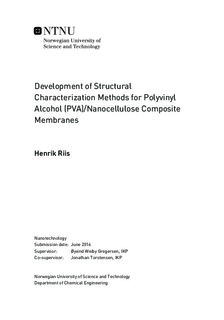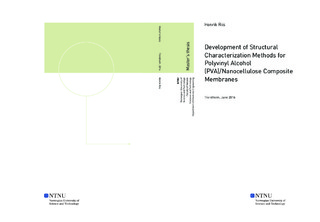| dc.description.abstract | Structural characterization of polyvinyl alcohol (PVA)/nanocellulose films by scanning electron microscopy (SEM) generally only provides an qualitative estimate of how well the nanocellulose is distributed, and is not capable of giving detailed information on individual nanocellulose particles. Nor do the existing techniques preserve the native, porous state of the water-rich film or allow for uncoated imaging of the polymer films. In an effort to address this, new characterization methods have been developed. This has been done by image analysis of field-emission SEM images which revealed a segregation effect in both cellulose nanocrystal and cellulose nanofibril containing PVA films. This was believed to be caused by nanocellulose preferring the water phase over the solid matrix and receding with the water during drying. Further, methods using focused ion beam-SEM (FIB-SEM) and reactive ion etching (RIE) have been developed. FIB-SEM cross-sections of stained and unstained samples yielded no direct observation of nanocellulose, but voids believed to be at the PVA/nanocellulose interface were possibly seen. Preservation of the porous structure was done by liquid ethane and nitrogen freeze-drying. Samples frozen in liquid ethane observed in FIB-SEM showed a significant increase in cross-section features believed to be interfacial voids. This may indicate a partial preservation of the porous structure. RIE of the films resulted in surface roughening and a suitable etching recipe was not determined. However, several observations were made indicating the problem originated from surface heating during etching. High-energy particles bombarding the surface and exothermic surface reactions may be the cause of heating combine with poor heat conduction of PVA. Low-voltage SEM (LVSEM) successfully imaged uncoated surfaces with acceleration voltages around 1.4 kV because this range resulted in nearly zero surface charging. Much of the work was also supported by Monte Carlo simulations to determine the viability and likely starting parameters of experiments. | |

